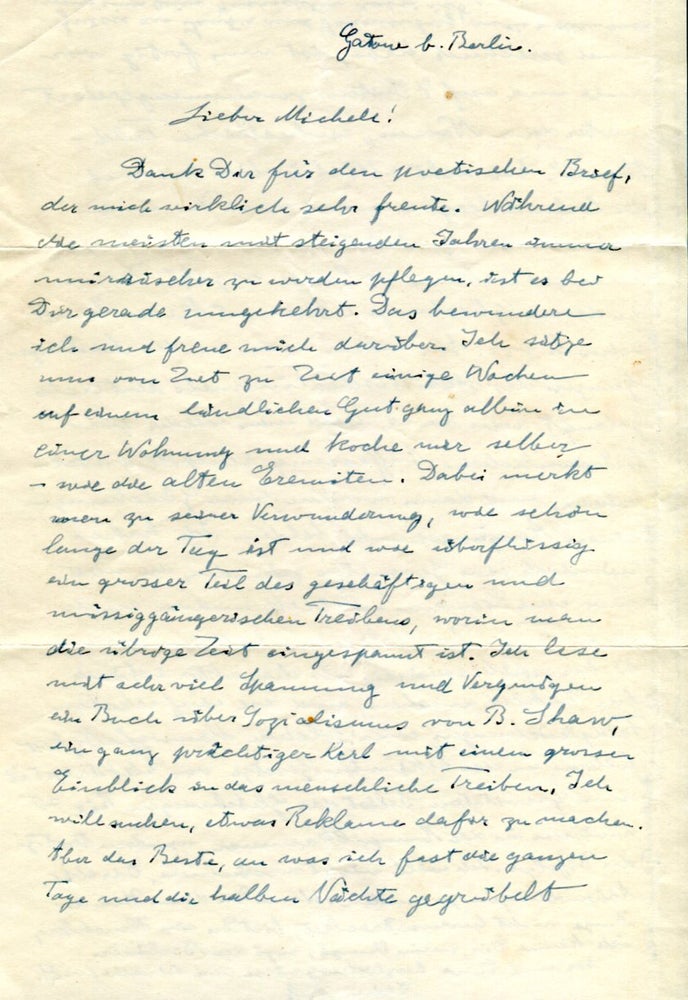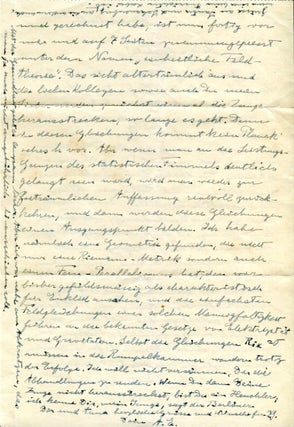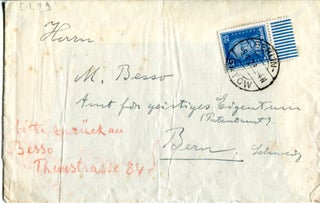Autograph Letter Signed
“[T]he very best thing, on which I have worked for days and half the nights, speculating and making calculations, is now completed and lying in front of me, compressed into seven pages with the title 'Unified Field Theory.' It looks antiquated, and the dear colleagues, including you, my dear, will initially stick their tongues out as far as possible. After all, these equations do not contain Planck's constant h. But once they have clearly reached the performance limit of the statistics craze, people will remorsefully return to the time-space concept, and then these equations will constitute a point of departure...”
HISTORICAL AUTOGRAPH LETTER SIGNED ANNOUNCING THE COMPLETION OF HIS UNIFIED FIELD THEORY.
By the end of 1928, news began circulating that Einstein was on the verge of a major scientific breakthrough, namely that he had succeeded in uniting the two pillars of modern physics, general relativity and quantum theory. In November 1928 The New York Times reported “Einstein of the Verge of Great Discovery” and sent a reporter to interview him about his impending publication on the subject. “The physicist’s parting words to the journalist were, ‘I can’t understand why all the fuss is being made about my little manuscript’... A letter Einstein wrote to Michele Besso, in early January 1929, “ however [the present letter], “reveals how much this ‘little manuscript’ really meant to him: ‘But the best thing, which I have been pondering and figuring out for days on end and half the night, is now complete before me, condensed into seven pages and titled “A Unified Field Theory”’...
“At the beginning of the 1920s, Einstein had made his first foray into the unknown terrain that would someday bring together the realms of the giants and the dwarfs, the macrocosm and the microcosm. He wanted to merge the two field theories into a single one, electrodynamics according to Maxwell and Lorentz and gravitation as described in his general theory of relativity. He regarded the physical field as the greatest achievement of science, a ‘point of view,‘ as he later confided to Erwin Schrödinger, ‘that has driven me into deep solitude. The ‘unified field theory‘ became his mania, his mantra, and his martyrdom...
“In January 1929 [in this same letter], Einstein described to Besso the idea he had come up with for a new unified field theory. He was exuberant. ‘It looks old-fashioned,‘ he said, ‘and our dear colleagues, including you, my dear man, will stick out your tongues as far as you can at first, because Planck’s constant (h) doesn’t appear in these equations, but when the limits of the statistical mania have clearly been reached, there will be a rueful return to the spatiotemporal interpretation of spacetime, and these equations will form a starting point.’” (Jürgen Neffe, Einstein: A Biography, pp. 350-353).
When his theory was published later in the month it was greeted with frenzied attention: “The Prussian Academy printed a thousand copies of Einstein’s paper, an unusually large number. When it was released on January 30, all were promptly sold, and the Academy went back to the printer for three thousand more. One set of pages was pasted in the window of a London department store, where crowds pushed forward to try to comprehend the complex mathematical treatise with its thirty-three arcane equations not tailored for window shoppers... The New York Times, for its part, raised the unified theory to a religious level by sending reporters that Sunday to churches around the city to report on the sermons about it.” (Walter Isaacson, Einstein: His Life and Universe, pp. 341-343).
Alas, the scientific community was not so impressed and his new unified field theory failed to pass the scrutiny of his colleagues. “Einstein gave up the [1929] theory within the year. But he did not give up the quest” and this letter documents perhaps the most dramatic moment along his all-consuming quest to discover the secrets of the universe. (Isaacson, p.344).
The letter, dated January 5, 1929, and written to Einstein’s lifelong friend Michele Besso (translated from the German) reads in full:
Dear Michele! / Thank you for the poetic letter. It really made me very happy. While it is usual for most people to become ever grumpier with increasing age, with you the exact opposite is true. I admire this and it makes me happy. Currently, for several weeks at a time every now and then, I live all by myself in an apartment on a rural estate, and I cook for myself - just like the old hermits. While doing this, one realizes with surprise how beautifully long the day is and how unnecessary so many of the busy and also the idle pursuits are which keep us occupied the rest of the time. With great excitement and joy, I am reading a book on Socialism by B. Shaw [likely "The Intelligent Woman's Guide to Socialism and Capitalism"], a truly splendid chap with great insights into human activities. I will try to promote it a bit. However, the very best thing, on which I have worked for days and half the nights, speculating and making calculations, is now completed and lying in front of me, compressed into seven pages with the title 'Unified Field Theory.' It looks antiquated, and the dear colleagues, including you, my dear, will initially stick their tongues out as far as possible. After all, these equations do not contain Planck's constant h. But once they have clearly reached the performance limit of the statistics craze, people will remorsefully return to the time-space concept, and then these equations will constitute a point of departure. You see, I have found a geometry that contains not only a Riemannian metric but also a distant parallelism, which until now we instinctively considered to be a characteristic of Euclidean geometry, and the simplest field equations of such a multiplicity lead to the known laws of electricity and gravitation. Even the equations Rik = o, in spite of the success they have obtained, will have to be relegated to the junk heap. I will not neglect to send you the papers. If you do not stick out your tongue then, you are a hypocrite; I know you, my boy, as the Berliners say.
Warmest greetings to you and Anna, and best wishes for 1929. / Your A.E. / Give my regards to Sauter and Schauenberg, and to the others as well, if they are present while you are relaying them. / My health is slowly getting better. However, I actually was close to kicking the bucket - something one should not postpone for an unreasonable time anyway.
Written from Gatow, Germany on January 5, 1929, on two pages of a 5.75" x 8.25" sheet, beautifully penned by Einstein in blue ink. With the original transmittal envelope measuring 6" x 4". Usual folds, otherwise fine condition. Housed in custom presentation folder.
Check Availability:
P: 212.326.8907
E: michael@manhattanrarebooks.com



